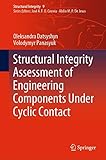Structural Integrity Assessment of Engineering Components Under Cyclic Contact [electronic resource] / by Oleksandra Datsyshyn, Volodymyr Panasyuk.
By: Datsyshyn, Oleksandra [author.] .
.
Contributor(s): Panasyuk, Volodymyr [author.] | SpringerLink (Online service)
| SpringerLink (Online service) .
.
Material type:  BookSeries: Structural Integrity: 9Publisher: Cham : Springer International Publishing : Imprint: Springer, 2020Edition: 1st ed. 2020.Description: XIII, 313 p. 183 illus., 1 illus. in color. online resource.Content type: text Media type: computer Carrier type: online resourceISBN: 9783030230692.Subject(s): Mechanics, Applied
BookSeries: Structural Integrity: 9Publisher: Cham : Springer International Publishing : Imprint: Springer, 2020Edition: 1st ed. 2020.Description: XIII, 313 p. 183 illus., 1 illus. in color. online resource.Content type: text Media type: computer Carrier type: online resourceISBN: 9783030230692.Subject(s): Mechanics, AppliedPreface -- Chapter 1. Methods of tribojoint elements contact lifetime estimation. A review -- Chapter 2. Calculation model for estimation of cyclic contact lifetime of body with cracks -- Chapter 3. Singular integral equations for some contact problems of elasticity theory for bodies with cracks -- Chapter 4. Rolling contact fatigue. Contact fatigue damages and paths of crack growth in rolling bodies contact zone and estimation of their lifetime by damages formation criteria -- Chapter 5. Fretting fatigue fracture -- References.
This book synthesizes the results of author’s researches and results from known publications in the field of surface layers fracture of cyclical contacting bodies (machine parts). The calculation models and calculating procedures of stress-strain states of cyclically contacting solids with cracks, have been proposed. On this basis, the cracks paths propagation which form nearsurface damages have been constracted, taking into consideration the tribojoint operating parameters and crack growth resistance characteristics of materials by transverse shear and normal opening. The computer methodology to study fracture processes in tribojoint elements contact area and estimation of their residual lifetime by the criteria of typical contact fatigue damages formation (spalling, pitting, cracking, "dark spots", cavities etc.) has been developed. Recommendations for optimizing operating parameters of joints (contact stresses magnitude, friction/lubrication conditions, materials crack resistance etc) for elements of rolling pairs (wheel–rail systems, backup roll – working roll of rolling mills etc.) and some fretting pairs are formulated.


There are no comments for this item.